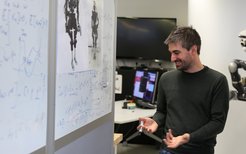Award-winning junior scientists
Tatjana Tchumatchenko, Tobias Erb and Ludovic Righetti receive the Heinz Maier-Leibnitz Prize 2016
The most important German prize for junior scientists is awarded annually by the German Research Foundation (DFG), with each prize winner receiving 20,000 euros. The three Max Planck scientists will be presented with this major award on 18 May in Harnack House in Berlin – together with seven other prize winners.
Ludovic Righetti: Teaching robots to walk

Computer scientist Ludovic Righetti is investigating how robots can be taught to walk. He models his ideas on movement patterns from nature such as the climbing skills of animals.
When the 34-year-old researcher knocks the two-legged robot Hermes off balance, it corrects its stance with an almost human rebalancing act. The new control unit which Stefan Schaal and Ludovic Righetti have installed in Hermes is already setting a precedent: “It is meanwhile being used in a lot of robots,” says Righetti. The control unit will help the youngest member in the Olympia of the robots at the Tübingen-based Max Planck Institute for Intelligent Systems with balance: Athena, the first robot to occupy a seat on a flight from the USA to Germany.
And she doesn’t quite fulfil the expectations associated with the name of the goddess, either. A broad chest, powerful arms, hydraulic tubes and her robot-like head, which she doesn’t always wear, make her look like a Transformer. But she does have - arms and legs.
The research undertaken by Ludovic Righetti and his team in the future will concentrate on how Athena can best coordinate all her limbs when she is to solve several simultaneous tasks. And also how she sets the right priorities when she is to move over uneven terrain or stand still and reach for an object. After all, the machine does not initially know what is more important. A useful helper for everyday tasks, on the other hand, must make sensible decisions in such cases. “It will still be a while before robots become autonomous enough to support people who need help,” says Righetti. “There are still too many points in the cycle of perception, learning and action where the robotics must be significantly readjusted.”
In 2014, Righetti was awarded an ERC Starting Grant for his research work. After studying in Switzerland and doing postdoc work in the US, Righetti formed a junior research group at the Max Planck Institute for Intelligent Systems in Tübingen, which he still leads.
Tobias Erb: Understanding the biochemistry of microbes

Plants fix the greenhouse gas carbon dioxide. What is not widely known is that bacteria are also capable of doing this – sometimes much more efficiently than plants. Certain enzymes in microorganisms operate 10 to 100 times faster than their counterpart in plants.
36-year-old Tobias Erb and his team at the Max Planck Institute for Terrestrial Microbiology in Marburg investigate the biochemistry of this microbial CO2 fixation. “It is not yet possible to remove the greenhouse gas CO2 from the atmosphere and convert it into sustainable raw materials such as biodiesel,” says the microbiologist. “Over the course of evolution, a great many different enzymes have evolved which can help us to fix CO2 on the gigatonne scale.”
The scientists want to learn the tricks of the microbes in order to then reproduce them in a test tube. They do this by combining an only recently discovered CO2-fixing enzyme from purple bacteria with further enzymes and making them into an artificial metabolic pathway. “Even though the long-term goal is to drive forward the efficient conversion of climate-damaging CO2 into biomass, we are also interested in the fundamental question of whether we can redesign and optimize a key biological process by rigorously applying our scientific understanding.”
Their project is supported not only by the German Research Foundation, but also by the European Research Council (ERC), which has awarded Tobias Erb a Starting Grant. Furthermore, the microbiologist has been a member of the Junge Akademie of the Berlin-Brandenburg Academy of Sciences and Humanities, and the National Academy of Natural Sciences Leopoldina, since 2013.
Tatjana Tchumatchenko: Making neuronal processes in the brain measurable

Neuronal processes in the brain can be measured only indirectly. Their behaviour is not linear and is subject to a high degree of variability on various temporal and spatial scales. Meaningful theoretical models which contribute to a useful quantitative evaluation and comparability of neuronal data represent a great challenge.
35-year-old Tatjana Tchumatchenko, who heads the “Theory of neuronal network dynamics” Working Group at the Max Planck Institute for Brain Research in Frankfurt/Main, investigates the dynamics and information processing of neuronal systems, from individual nerve cells through to neuronal networks. She has developed mathematical models to describe and analyze dynamic and static properties of biological neuronal networks. “This has enabled her to provide significant insights for the theoretical neurosciences,” according to the decision of the jury.
Tatjana Tchumatchenko has already received an award from the Behrens-Weise Foundation in 2012 and in 2011 a Volkswagen scholarship in the field of “computational sciences". Moreover, she had a scholarship from the German National Academic Foundation from 2004 to 2006.
In recognition of their work, and at the same time as an incentive to pursue their scientific career in the same vein, the Heinz Maier-Leibnitz Prize has been awarded annually to outstanding young researchers since 1977. The prize winners for 2016 were selected from a total of 134 proposed candidates.
DFG/BA


